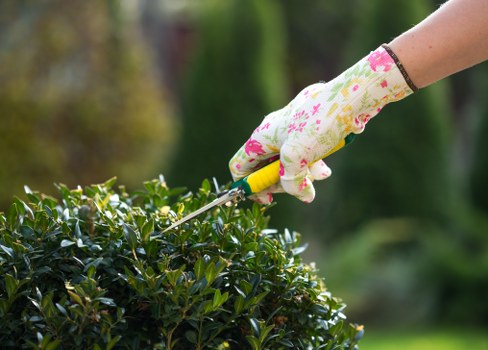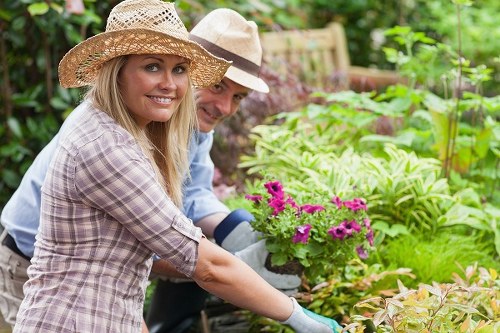Comprehensive Guide to Garden Maintenance in Get ? Gardener

Maintaining a beautiful garden requires dedication, knowledge, and the right tools. In Get, finding a reliable gardener to assist with garden maintenance can transform your outdoor space into a vibrant and inviting area. This guide explores essential aspects of garden maintenance, providing valuable insights for both novice and experienced gardeners.
From seasonal tasks to regular upkeep, understanding the various components of garden maintenance ensures your garden remains healthy and aesthetically pleasing throughout the year. Whether you're aiming to cultivate a flower paradise or a functional vegetable garden, proper maintenance is key to achieving your gardening goals.
In this article, we'll delve into the best practices for garden care, the benefits of hiring a professional gardener in Get, and practical tips to keep your garden thriving. Let's embark on a journey to make your garden the envy of the neighborhood.

The Importance of Regular Garden Maintenance
Regular garden maintenance is essential for several reasons. Firstly, it promotes the healthy growth of plants by ensuring they receive adequate nutrients, water, and sunlight. Consistent care helps in identifying and addressing issues like pests, diseases, and nutrient deficiencies before they become severe problems.
Secondly, a well-maintained garden enhances the overall aesthetic appeal of your property. It creates a welcoming environment, providing a serene space for relaxation and recreation. Proper maintenance also increases the value of your home, making it more attractive to potential buyers if you decide to sell.
Lastly, taking care of your garden contributes to environmental sustainability. Healthy plants improve air quality, support local wildlife, and contribute to the local ecosystem. By maintaining your garden, you're also promoting a greener and more sustainable environment.

Key Aspects of Garden Maintenance
1. Watering
Proper watering is crucial for the survival and growth of your plants. Different plants have varying water requirements, so it's important to understand the needs of each species in your garden.
Overwatering can lead to root rot and other fungal diseases, while underwatering can cause plants to wilt and become stressed. Implementing an efficient watering system, such as drip irrigation, can help manage water usage effectively.
Tip: Water your garden early in the morning or late in the evening to minimize evaporation and ensure that plants absorb adequate moisture.
2. Fertilizing
Fertilizing your garden provides essential nutrients that promote healthy plant growth. Organic fertilizers, such as compost and manure, are excellent choices for enriching the soil naturally.
Inorganic fertilizers can supply specific nutrients quickly but should be used sparingly to prevent soil imbalances. Testing your soil periodically can help determine the appropriate type and amount of fertilizer needed.
Note: Always follow the manufacturer's instructions when applying fertilizers to avoid over-fertilization, which can harm plants and the environment.

3. Pruning
Pruning involves the selective removal of certain parts of a plant, such as branches, buds, or roots. This practice helps maintain the plant's shape, encourages healthy growth, and removes dead or diseased parts.
Regular pruning improves air circulation within the plant canopy, reducing the risk of fungal infections and pest infestations. It also enhances the plant's appearance, ensuring it remains well-structured and visually appealing.
Pro Tip: Use sharp, clean tools for pruning to make precise cuts and minimize damage to the plant.

4. Weeding
Weeds compete with your garden plants for nutrients, water, and sunlight. Regularly removing weeds helps reduce competition and prevents them from spreading.
Manual weeding is an effective method, especially for small gardens. For larger areas, consider using mulch or landscape fabric to suppress weed growth. Additionally, applying natural herbicides can help manage persistent weeds without harming your desired plants.
Remember: Consistent weeding is key to maintaining a healthy and weed-free garden.
Seasonal Garden Maintenance Tips
Spring
Spring is a critical time for garden maintenance as it sets the tone for the growing season. Start by clearing any debris left over from winter, such as fallen leaves and dead branches.
Prepare your soil by adding compost or organic matter to improve its structure and fertility. Plant new seedlings and prune perennial plants to encourage robust growth. It's also an ideal time to inspect your garden for any signs of pests or diseases.
Spring Cleaning: Remove old mulch and replace it with fresh material to help retain soil moisture and suppress weeds.
Summer
During the summer months, focus on maintaining adequate moisture levels and protecting plants from excessive heat. Implementing shade cloths or using row covers can help shield sensitive plants from harsh sunlight.
Regularly monitor for pests and diseases, taking prompt action to address any issues. Continue to fertilize your plants, but adjust the frequency based on their growth and water needs.
Pro Tip: Mulch your garden beds to conserve moisture and regulate soil temperature.

Fall
Fall is the time to prepare your garden for the colder months. Begin by harvesting any remaining produce and removing spent plants. Clean up fallen leaves and debris to prevent the spread of diseases.
Planting cover crops can help enrich the soil and prevent erosion during winter. Additionally, prune trees and shrubs to remove any dead or damaged branches, promoting healthy growth in the spring.
Winter Preparation: Protect sensitive plants by mulching around their bases and covering them with frost cloths if necessary.
Winter
In winter, garden maintenance shifts to protecting your garden structures and preparing for the next growing season. Inspect and repair any garden tools and equipment, ensuring they're ready for use in the spring.
Store hoses, irrigation systems, and other equipment properly to prevent damage from freezing temperatures. Use this time to plan your garden layout, choose new plants, and make any necessary adjustments.
Planning Ahead: Take advantage of the quieter months to design and strategize for a more efficient and productive garden next year.

Hiring a Professional Gardener in Get
While DIY garden maintenance can be fulfilling, hiring a professional gardener in Get offers numerous benefits. Professional gardeners possess the expertise and experience to manage all aspects of garden maintenance efficiently and effectively.
They can assess your garden's specific needs, recommend appropriate plants, and implement tailored maintenance plans. Additionally, professional gardeners have access to specialized tools and resources, ensuring high-quality results.
Benefits of Hiring a Professional:
- Expert knowledge of local climate and soil conditions
- Efficient handling of pests and diseases
- Customized maintenance schedules
- Time-saving, allowing you to enjoy your garden without the hassle of upkeep

Choosing the Right Gardener
When selecting a professional gardener in Get, consider the following factors to ensure you make the best choice:
- Experience: Look for gardeners with a proven track record and extensive experience in garden maintenance.
- Reputation: Read reviews and ask for references to gauge the quality of their services.
- Services Offered: Ensure the gardener provides the specific services you need, such as pruning, fertilizing, and pest control.
- Cost: Compare pricing structures and ensure they fit within your budget without compromising on quality.
Tip: Interview potential gardeners to discuss your garden’s needs and assess their communication skills and professionalism.
Establishing a Maintenance Schedule
Work with your professional gardener to establish a maintenance schedule that suits your garden's requirements. A structured schedule ensures that all necessary tasks are performed timely, promoting the health and beauty of your garden.
The schedule should include regular activities like watering, weeding, pruning, and seasonal tasks such as planting and harvesting. Flexibility is also important to accommodate any unexpected issues that may arise.
Customization: Tailor the maintenance plan to address specific challenges in your garden, such as drought-prone areas or susceptibility to certain pests.

Essential Tools for Garden Maintenance
Having the right tools is fundamental for effective garden maintenance. Whether you’re a DIY enthusiast or hiring a professional gardener, these tools can make your gardening tasks easier and more efficient.
Basic Tools: Hand trowels, pruning shears, garden forks, and spades are essential for various gardening tasks. These tools help in planting, weeding, and soil preparation.
Advanced Tools: Consider investing in tools like electric pruners, hose reels, and soil testers for more specialized tasks. These can enhance productivity and ensure precise maintenance.
Tool Maintenance
Proper maintenance of your gardening tools extends their lifespan and ensures they perform optimally. Clean tools after each use to prevent rust and corrosion. Sharpen blades regularly and store tools in a dry, secure place.
Safety: Always handle tools with care and use appropriate safety gear to prevent injuries during maintenance tasks.
By maintaining your tools, you ensure they remain effective and safe for all your gardening needs.
Effective Pest and Disease Management
Pests and diseases can severely impact the health of your garden. Implementing effective management strategies is crucial to protect your plants and maintain a thriving garden.
Identification: Regularly inspect your plants for signs of pests or diseases. Early detection allows for prompt and effective treatment, minimizing damage.
Natural Remedies: Utilize organic pest control methods, such as introducing beneficial insects or using neem oil, to manage pests without harming the environment.
Integrated Pest Management (IPM)
IPM is a holistic approach to pest control that combines biological, cultural, and chemical methods. It focuses on long-term prevention and minimal environmental impact.
Steps in IPM:
- Monitor pest populations
- Identify pest species accurately
- Implement control measures only when necessary
- Evaluate the effectiveness of the management strategies
Benefit: IPM promotes sustainable gardening practices, reducing reliance on harmful chemicals and fostering a balanced ecosystem.
By adopting these strategies, you can effectively manage pests and diseases, ensuring the longevity and vitality of your garden.

Soil Health and Improvement
Healthy soil is the foundation of a thriving garden. It provides essential nutrients, supports plant roots, and facilitates water retention and drainage.
Soil Testing: Regularly test your soil to determine its pH levels and nutrient content. This information helps in selecting appropriate fertilizers and amending the soil as needed.
Amending Soil: Incorporate organic matter, such as compost or aged manure, to enhance soil structure and fertility. This also promotes beneficial microbial activity, contributing to overall soil health.
Composting
Composting is an effective way to recycle garden waste and kitchen scraps into nutrient-rich fertilizer. It improves soil texture, increases nutrient content, and enhances moisture retention.
How to Compost: Create a compost pile by layering green materials (like grass clippings and vegetable scraps) with brown materials (such as dried leaves and straw). Maintain the pile by turning it regularly to aerate and accelerate decomposition.
Tip: Avoid composting meat, dairy, and oily foods to prevent odors and pest attraction.
Mulching
Mulching involves covering the soil surface with materials like bark, straw, or compost. It helps in retaining soil moisture, suppressing weeds, and regulating soil temperature.
Benefits of Mulching:
- Reduces water evaporation
- Prevents weed growth
- Enriches soil as it decomposes
- Protects plant roots from extreme temperatures
Recommendation: Apply a 2-3 inch layer of mulch around your plants, ensuring it's not piled up against plant stems to prevent rot.

Plant Selection and Placement
Choosing the right plants and their placement in your garden is vital for successful garden maintenance. Consider factors such as climate, soil type, light exposure, and water availability when selecting plants.
Native Plants: Opting for native species can reduce maintenance efforts, as they are well-adapted to the local environment and are more resistant to pests and diseases.
Design Tips: Group plants with similar water and light requirements together to simplify maintenance and ensure optimal growth conditions.
Companion Planting
Companion planting involves growing different plants together that benefit each other. This practice can enhance growth, deter pests, and improve overall garden health.
Examples:
- Tomatoes and basil: Basil repels certain pests and enhances the flavor of tomatoes.
- Cabbage and chamomile: Chamomile attracts beneficial insects that help control cabbage pests.
- Carrots and onions: Onions help repel carrot flies, while carrots can improve the growth of onions.
Benefit: Companion planting promotes a balanced ecosystem, reducing the need for chemical interventions and fostering a healthier garden environment.
Succession Planting
Succession planting involves staggering the planting times of certain crops to ensure a continuous harvest throughout the growing season. This technique maximizes garden productivity and reduces periods of low yield.
How to Implement: After harvesting early-season crops like lettuce or radishes, replant the same area with later-season crops such as beans or squash.
Advantage: Succession planting optimizes space usage and ensures that your garden remains productive from spring through fall.

Implementing Sustainable Garden Practices
Adopting sustainable practices in your garden not only benefits the environment but also enhances the long-term health and productivity of your garden. Sustainable gardening focuses on minimizing waste, conserving resources, and promoting biodiversity.
Water Conservation: Implement rainwater harvesting systems to collect and store rainwater for garden use. This reduces dependence on municipal water supplies and lowers your water bills.
Eco-Friendly Tools: Use biodegradable pots, compostable plant labels, and recycled materials for garden structures to minimize environmental impact.
Encouraging Biodiversity
A diverse garden supports a wide range of plant and animal species, creating a balanced ecosystem. Incorporate a variety of plants, including flowering species, to attract pollinators like bees and butterflies.
Wildlife Habitats: Provide habitats for beneficial insects, birds, and other wildlife by installing birdhouses, insect hotels, and water features. These creatures help control pests and contribute to the overall health of your garden.
Benefits: Biodiversity enhances resilience against pests and diseases, ensuring a more robust and sustainable garden.
Reducing Chemical Usage
Minimize the use of chemical fertilizers and pesticides by opting for natural alternatives. Organic methods are safer for the environment and promote healthier plant growth.
Organic Pest Control: Use neem oil, insecticidal soaps, or introduce predatory insects like ladybugs to manage pest populations naturally.
Soil Health: Focus on building healthy soil through composting and organic amendments, which enhances plant resistance to diseases and reduces the need for chemical interventions.

Maximizing Garden Efficiency
Optimizing garden efficiency involves smart planning and resource management to make your garden maintenance tasks easier and more effective. Implementing efficient techniques can save time, reduce effort, and enhance the overall productivity of your garden.
Layout Planning: Design your garden layout to maximize space utilization and accessibility. Consider pathways, plant spacing, and the arrangement of different plant types for easy maintenance.
Vertical Gardening: Utilize vertical space by incorporating trellises, shelves, or hanging pots. This not only saves ground space but also adds visual interest to your garden.
Efficient Watering Systems
Installing automated watering systems like drip irrigation or soaker hoses can significantly reduce the time and effort required for watering your garden. These systems deliver water directly to the plant roots, minimizing waste and ensuring consistent moisture levels.
Smart Controllers: Use smart irrigation controllers that adjust watering schedules based on weather conditions, soil moisture, and plant needs. This ensures optimal water usage and prevents overwatering.
Maintenance: Regularly check and maintain your watering systems to ensure they function correctly and efficiently.
Time-Saving Techniques
Adopt time-saving gardening techniques such as mulching, no-dig gardening, and companion planting. These methods reduce the need for frequent weeding, soil turning, and intensive care.
No-Dig Gardening: By minimizing soil disturbance, you preserve soil structure, retain moisture, and promote healthy root growth. This technique also reduces labor and enhances soil fertility.
Mulching Benefits: As mentioned earlier, mulching helps in weed suppression and moisture retention, thereby decreasing the time spent on watering and weeding.

Conclusion
Garden maintenance in Get is a rewarding endeavor that requires a combination of knowledge, effort, and sometimes professional assistance. By understanding the key aspects of garden care, implementing sustainable practices, and utilizing efficient maintenance techniques, you can ensure your garden remains lush, healthy, and beautiful throughout the year.
Whether you choose to undertake garden maintenance yourself or hire a professional gardener in Get, the results are well worth the investment. A well-maintained garden not only enhances the beauty of your home but also provides a peaceful sanctuary where you can relax and enjoy nature.
Ready to transform your garden? Contact us today to book your garden maintenance service and experience the difference a professional gardener can make!



